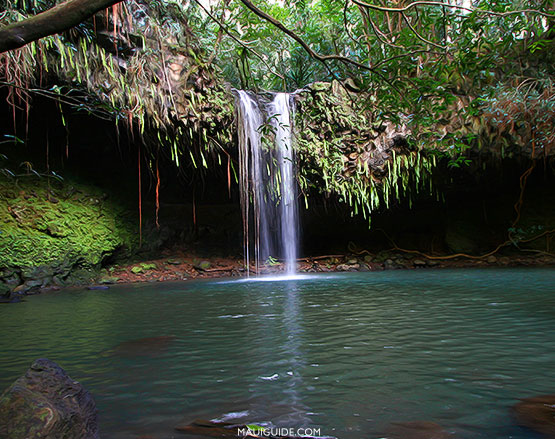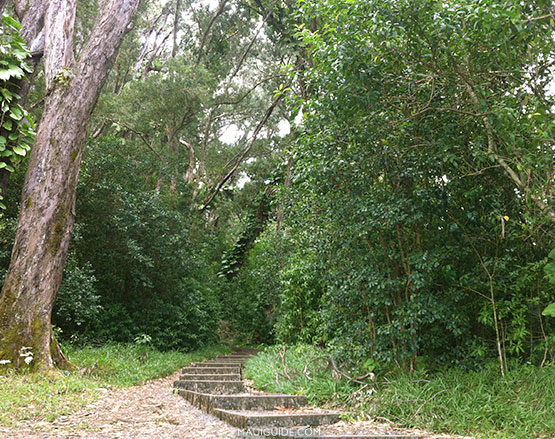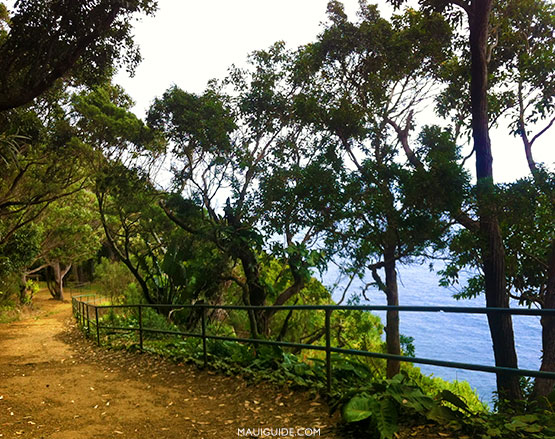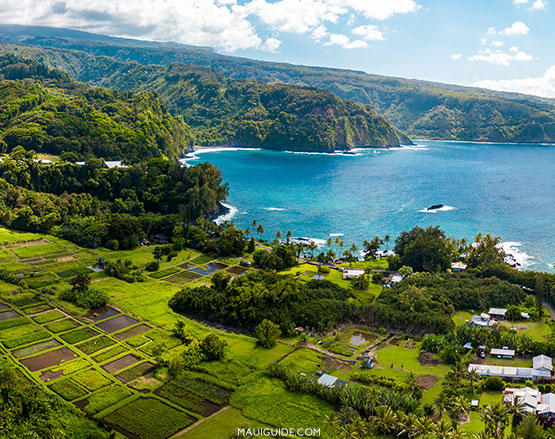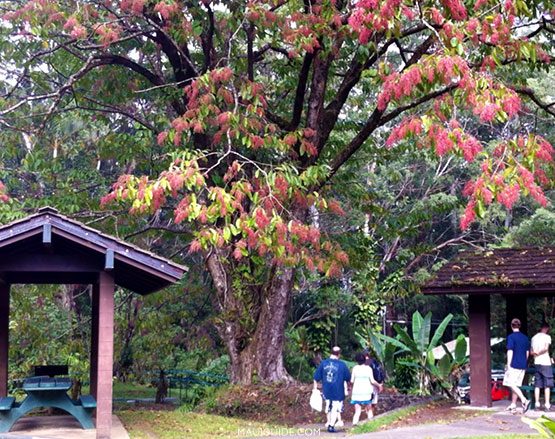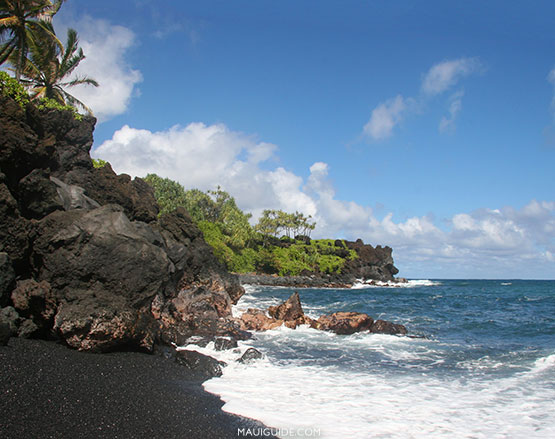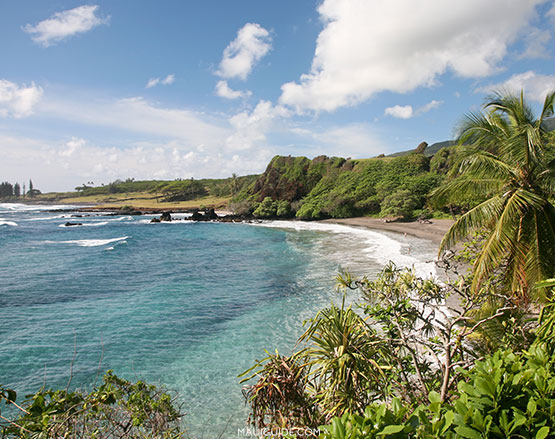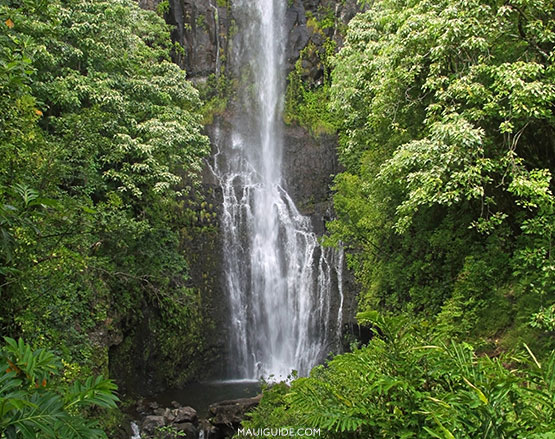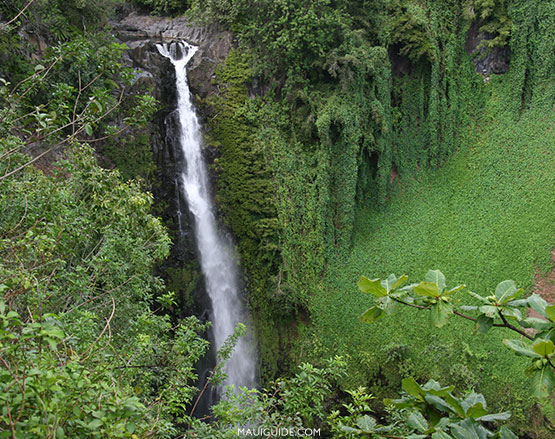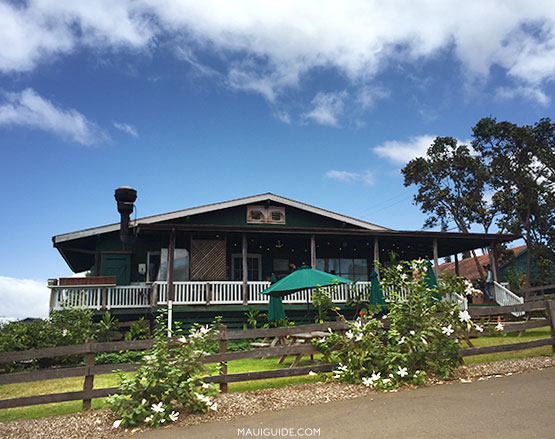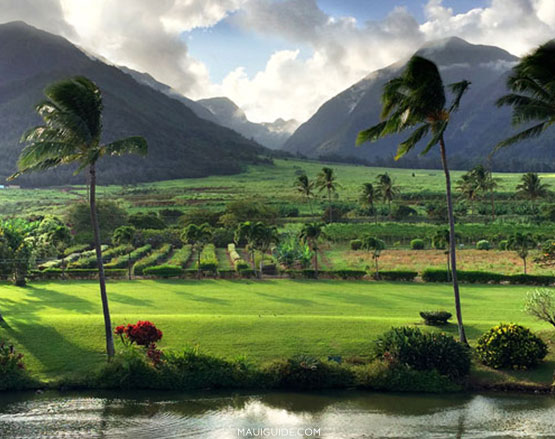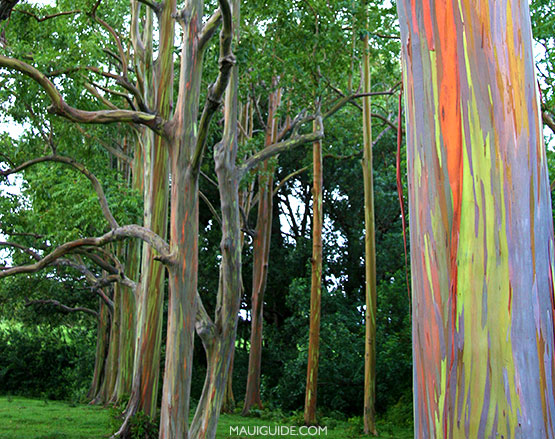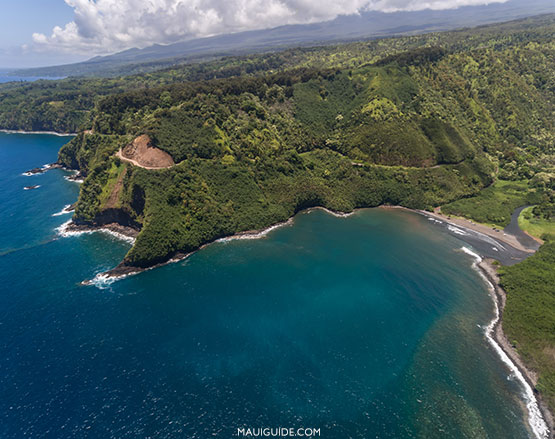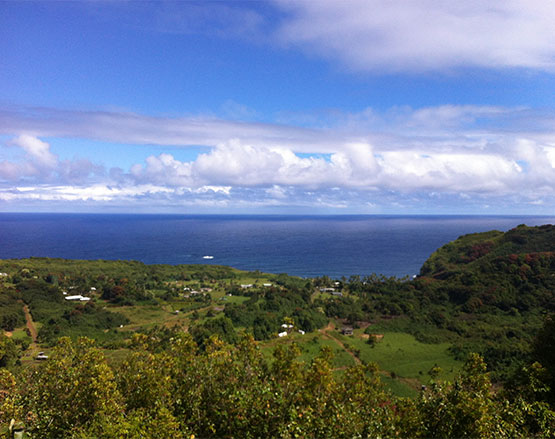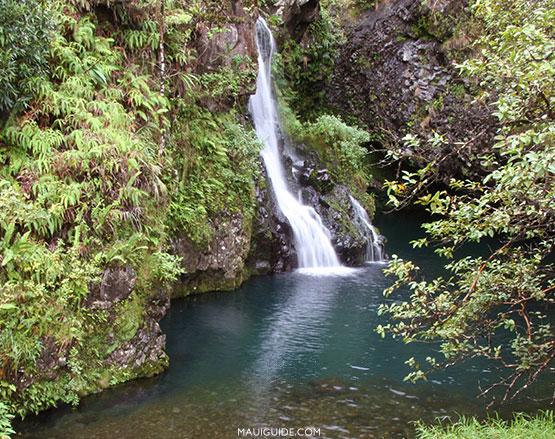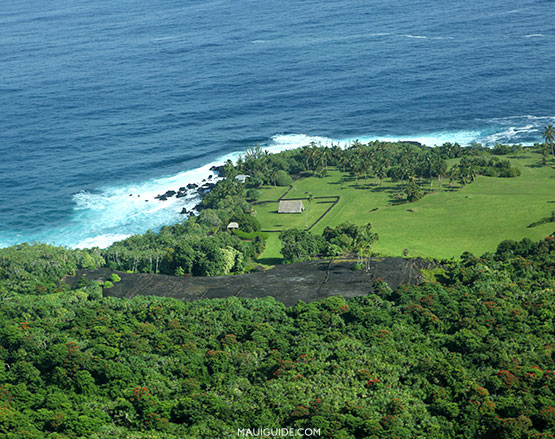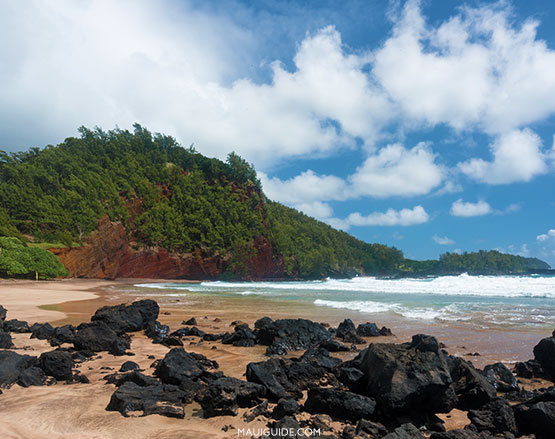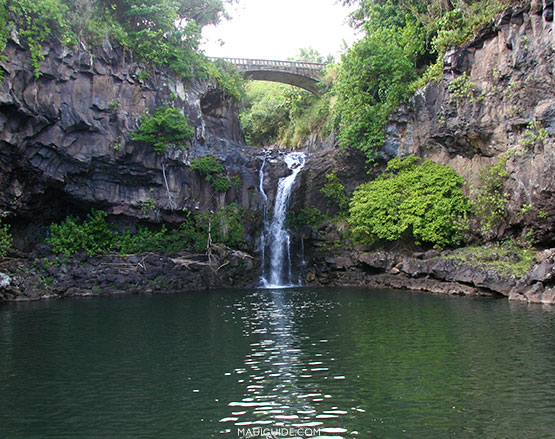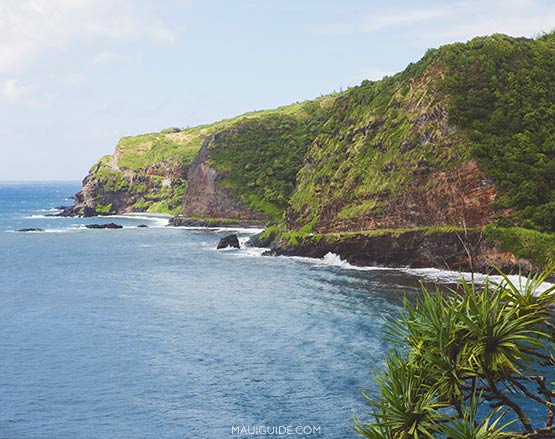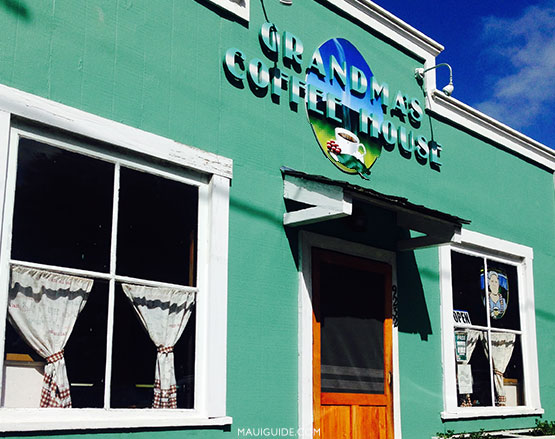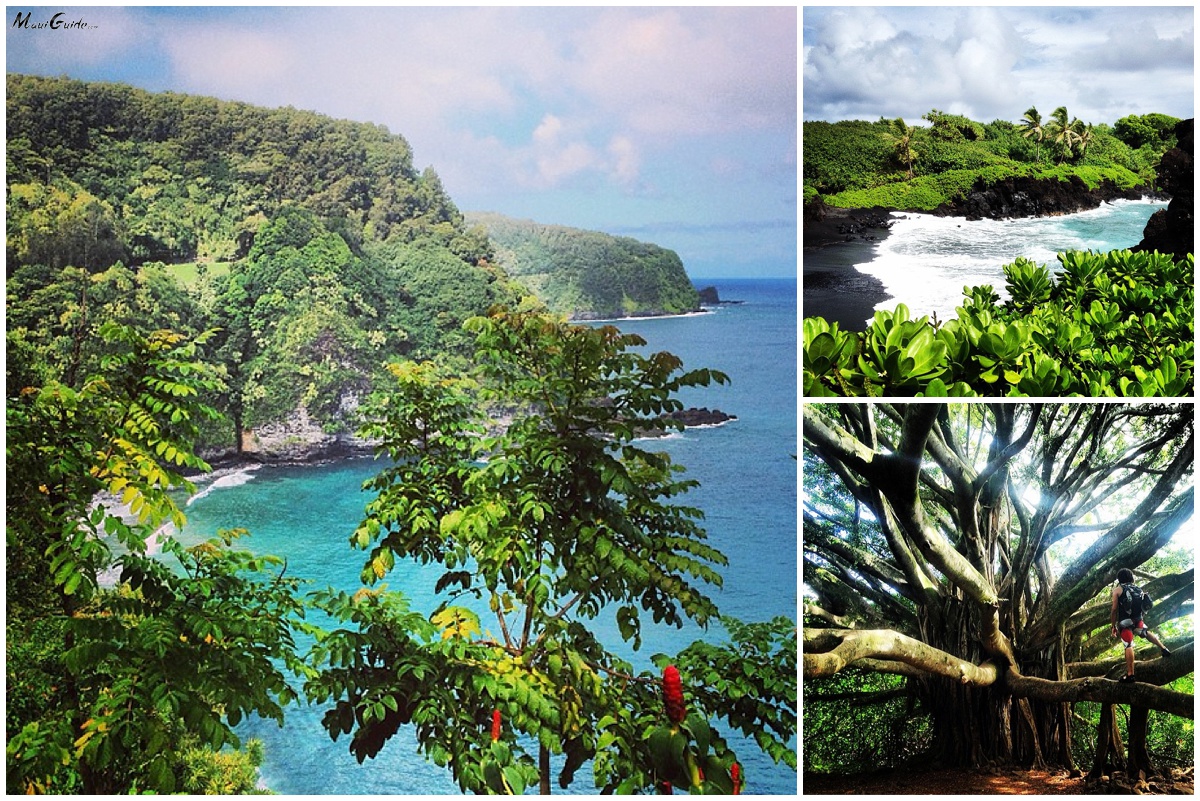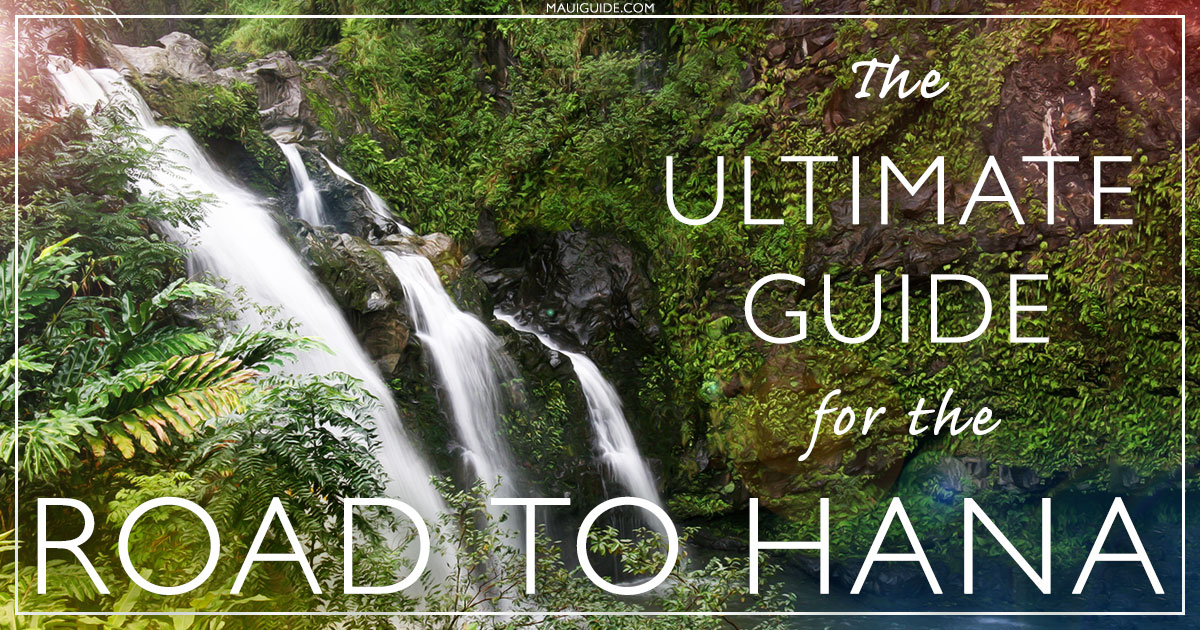
With around 620 turns and 59 narrow bridges, the Road to Hana makes for a legendary drive. Below you’ll find detailed information about the road to Hana, local tips, video, photos, & the latest updates. For those that subscribe to the Hana newsletter, get a Free Road to Hana Ebook.
Hana Stops • Preparation • Etiquette • Tips
Road to Hana
PAIA TOWN
Pa’ia has a well-deserved reputation for being one of the most eccentric places on Maui. Anything goes here, and the fantastic people watching combined with great food and unique shopping put this little town on the must-visit list. Pa’ia is located at the intersection of Hana Highway and Baldwin Avenue, and everything worth seeing can be found by wandering up and down these two streets. Park your car in the free lot on Hana Highway just west of town, and wander in and out of the many unique shops.
TWIN FALLS
The closest waterfalls to visit along the Road to Hana are about 10-15 minutes past Paia Town. You’ll see a bunch of cars parked to the right of you as you drive towards Hana (it’s popular because it’s close.)
You’ll have to do a short hike, but it’s easy. Most of the hike is made up of flat dirt roads. There are multiple falls along the trails, some easier to access than others. The people that own the land (Wailele Farms) put in an enormous amount of effort to maintain the area and keep it open for public use. They run the farm stand at the entrance, so don’t be afraid to ask them questions about the area, about their farm, and pick up some yummy coconut candy and a fresh smoothie!
WAIKAMOI RIDGE TRAIL
Waikamoi Ridge Trail rests between the hamlet of Kailua and the peninsula of Ke’anae on the mauka (or mountain) side of the road. A small trail offers a loop around the environs, taking you up the ridge and into the quiet, where there are few sounds beyond whistling bamboo and wild birds, including the sweetly-chatty Hawaiian Honeycreeper, ‘amakihi.
KAUMAHINA STATE WAYSIDE PARK
Kaumahina State Wayside Park is just one stop along the route that’s worth braking for. Boasting stellar views of Maui’s dramatic northeastern coastline, it reinforces why the Road to Hana is often thought as one of the most iconic drives in the world.
KEʻANAE PENINSULA
Located at Mile Marker 16.8, Keʻanae Peninsula has a reputation that precedes it. Meaning, glimpses of its beauty appear in the miles prior. The anticipation that builds before your arrival is greatly fulfilled: Presenting a rocky coastline and acres of taro, the fishing village has been beautifully preserved—even after it was devastated by a tsunami in 1946. What remains is veritably picturesque, from a stone church (the only surviving structure in the tsunami and one of the oldest churches in Hawaii) to a lava strip that stretches dramatically into the Pacific.
PUAʻA KAʻA STATE WAYSIDE PARK
Pua’a Ka’a—which translates to “rolling pig”—is one of the most accessible waterfalls on the Road to Hana, rendering it a solid option for those traveling with multiple generations. Its five acres provide not only restrooms but also covered picnicking opportunities and walking paths. Lush rainforests frame the cascades (16 and 25 feet, respectively), giving the park a heavenly scent of ginger and jungle. Ample parking is available; birders will be overjoyed by the abundant avian life.
NAHIKU MARKETPLACE
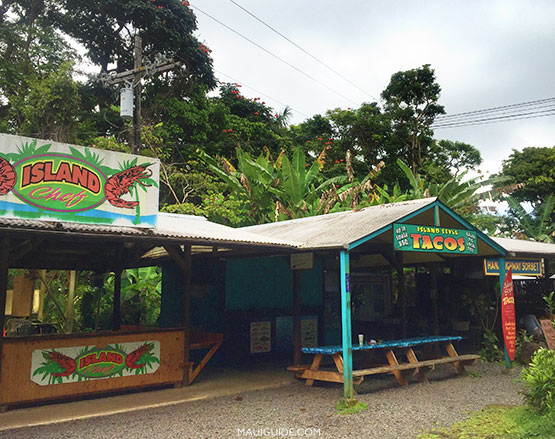
Tropical casual defines this hamlet, where breezy, open-air cafes offer solid fare ranging from Hana-caught beer battered fish and chips and kalua pork tacos to ahi tuna plates and good, old-fashioned hot dogs. Souvenirs are also available, with highlights that include island-made art, aloha-vibed clothing, Hawaiian icons, home décor, and hand-crafted jewelry.
HANA LAVA TUBES
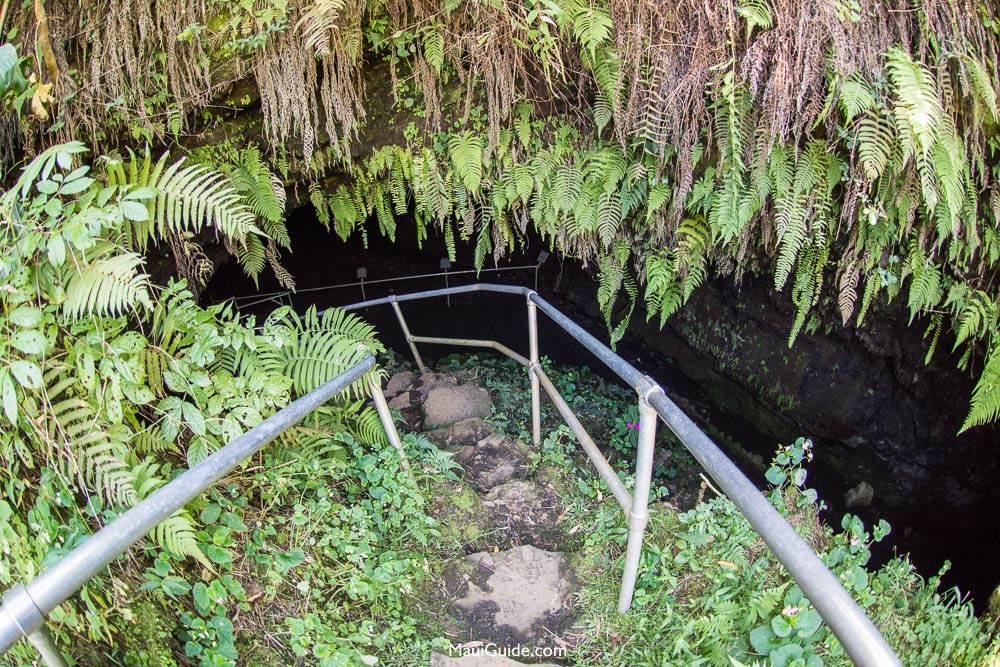
Located off the dramatic—and dramatically beautiful—Hana Highway on Ulaino Road, the Hana Lava Tubes (traditionally known as Kaʻeleku Caverns) were created more than a century ago during Maui’s last significant phase of volcanic activity. In essence a subterranean system of tunnels created by a massive flow of lava that cooled and hardened to form a cylinder through which lava rivers could continue to flow, the Hana Lava Tubes feature stunning stalactites, flowstone, stalagmites, fissures, cracks, and “piles” of lava (some of which reach several feet high)—in short, a step back into the island’s radical geological past.
WAIʻANAPANAPA STATE PARK
Stretching out along the lush coastline of East Maui, Waiʻanapanapa State Park easily goes down as one of the greatest highlights on the already-stunning Road to Hana. From underwater grottos to sea stacks, it’s not just a sight to savor but also an homage to ancient Hawaii—and a glorious place to explore.
HAMOA BEACH
With over 120 miles of coastline and coves in a rainbow of shades, it’s nearly impossible to assert which beach on Maui qualifies as the best. And yet, Hamoa Beach, a 1,000-foot-long cove on the island’s remote eastern shore, often finds its way into the debate. Flanked by lush sea cliffs and presenting views of ironwoods in the distance, this secluded beauty is hard to top in terms of loveliness and tranquility.
WAILUA FALLS
Located just past Mile Marker 44 on Hana Highway (after it’s turned into Hwy 31), Wailua Falls emerges roughly seven miles past Hana Town heading towards Oheo Gulch in Kipahulu. One of the most iconic and frequently photographed waterfalls on the island, its sheer accessibility makes it an instant crowd pleaser.
PIPIWAI TRAIL AND WAIMOKU FALLS
Located in Kipahulu—approximately twelve miles past Hana Town on the famed Road to Hana—Pipiwai Trail is frequently deemed one of the best, most worthwhile hikes in Hawaii. And for good cause: Roughly four-miles roundtrip, it highlights all the gorgeousness and magic East Maui has to offer, from out-of-this-world flora (think: an enormous banyan tree and native ferns) to ancient Hawaiian ruins.
ULAPALAKUA RANCH STORE
Ulupalakua Ranch Store & Grill is a welcome change from the tiki torch-lit restaurants that line the leeward side of the island. Tucked onto the ranch that gave it its name—an estate that once cultivated taro and sugarcane and is now renowned for its dairy cows and cattle—the charming, plantation-green venue redefines bucolic. With a menu that pulls from the island’s freshest bounty and the ranch’s own elk, beef, venison, and lamb, this is the spot to chow down while savoring the gentler pace of Maui.
MAUI TROPICAL PLANTATION
Most of you will be driving back to the south or west side to your hotel or condo. Unfortunately, there’s no straight shot to the south side (even though you can clearly see it)! Instead, you’ll be driving Upcountry to Kahului, then down through the Central Valley. Even though this adds time to your trip, there’s one big bonus: Stopping at the Maui Tropical Plantation. If you’ve left early enough for your adventure, you can enjoy a late lunch or dinner at Cafe O’Lei at the Mill House, with incredible views of the Waikapu Valley. The perfect end to an unforgettable day!
HO’OKIPA LOOKOUT
Set out to Hana and chances are you’ll be bewitched by the sight of surfers riding swells before you’ve even officially left the North Shore. Resting three miles past the former plantation town of Paia, Hookipa Beach Park—and the lookout it presents—is anything but, well, restful. Frequently deemed one of the most consistent Maui surf spots (if not the most windy), the beach is often abuzz with surfers—some with sails, others with kites— keiki splashing in the waves, and locals kicking back in the pavilions talking story.
RAINBOW EUCALYPTUS
We don’t recommend stopping to park here, as there isn’t much room and you can’t walk up to them (private property), but you can enjoy them as you drive by as well as look for more throughout East Maui. This impressive tree sheds an entire rainbow of bark, making for a very pleasing texture. On your way to Hana driving from Paia, you’ll see a row of these beauties on your left side.
GARDEN OF EDEN
It’s safe to say that more than a handful of places that equate themselves with Eden are leaning a tad too hard on hyperbole—or even hubris.
Unless, of course, said “Garden of Eden” is located in the lushest part of Maui—an island that’s frequently named the best in the world (and that’s no exaggeration). Presenting 26 acres of profuse but pristine beauty—as in, more than 700 species of plant life—this arboretum and botanical garden gives a whole new spin to the idea of thriving.
HONOMANU BAY
The valley—an erosion sculpted during Haleakala’s longest era of dormancy—possesses mountains that reach 7,000 feet, while the slopes that frame the secluded beach peak at 1,200. On the mauka (mountain) side of the bay, you’ll find Honomanu Stream—a solid option for wading, given that the ocean at the cove often presents hazardous waves. The first accessible beach after Hoʻokipa, it’s beloved by kamaʻaina, particularly surfers and fishermen; its felled ‘ohia, near the stream, makes for theatrical snapshots.
WAILUA VALLEY STATE WAYSIDE
Blink and you’ll miss it! This tiny little stop on the Road to Hana is home to some of the biggest views you can take in on Maui. Once you make your way to the top of the stairs you will have sweeping ocean views. Look behind you and see the dense Wailua Valley crawling all the way to the rim of Haleakala while thin strings of waterfalls accent its steep cliffs. Start looking to your right a little after mile marker 18 for the brown sign reading “Wailua Valley State Wayside.”
HANAWI FALLS
Hanawi Falls comprises two cascades: Its upper falls can be seen from the road while its lower cascade—which towers from a height of 200 feet—is situated on private property. Not to distress: Upper Hanawi Falls is also fantastic, gushing year-round from a peak of 30 feet and traversing 9 miles to the Pacific.
HANA FARMS
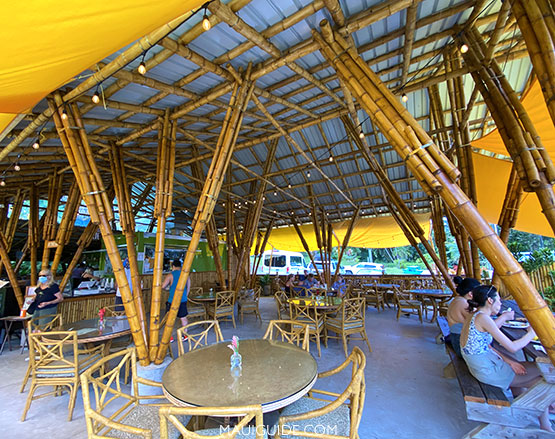
For great food, a really fun ambiance, and plenty of souvenirs and snacks for the road, Hana Farms is a must for those needing a break. We’re kicking ourselves for not having stopped and checked them out sooner. They’ve got amazing tacos, plenty of seating and parking and really fresh food from their farms. They even have live music on select weekends.
KAHANU GARDEN
Located on the lush and serpentine Road to Hana, the National Historic Landmark houses not only the largest sacred temple in Polynesia but also one of the biggest Pandanus (or hala) forests in Hawaii. Come to pay homage to Maui’s ancient culture—and to find a sense of tranquility on an island hopping with liveliness.
HANA TOWN
Hana is one of the few places in Hawaii where the land and the culture has remained almost untouched for hundreds of years. Travel the Road to Hana and arrive in the past.
Hana Much of the land in Hana Town is used for farming or raising cattle and other livestock. Ownership is divided into large parcels, which for the most part have been owned by the same families for generations.
KOKI BEACH
Located off Haneoʻo Road on Hana Highway, Koki Beach—which translates to “top of the peak”—is as dynamic as the island that created it. Summer months give the shelf of beach generous sand and mellow breezes; winter swells bring often-turbulent waters that tear the sand away and leave rocks and boulders in its place. The site of several drownings, it’s best to savor Koki Beach from the safety of land.
THE POOLS OF OHEʻO
Part of Haleakala National Park, Oheo Gulch is a great spot to visit, if you get that far. Here you’ll find multiple waterfalls and pools collecting at the base of each. This area offers hiking, camping, and some swimming. We recommend visitors to come here because the swimming areas are regulated by the park. In the case of possible flash floods, they will close the area.
We like this because it’s often impossible to predict a flash flood. Hence the “flash” part of it. The park rangers get a heads up from higher ground about weather conditions and know if the chances are higher than normal. DON’T BE STUPID! Swimming in non-park waterfall and stream areas can be incredibly risky. People die every year.
BACKSIDE
Most people double-back and miss some of the most stunning landscapes Maui has to offer. Continue along the circle and experience twice as much as you would otherwise.
GRANDMA’S COFFEE HOUSE
From Akamai Coffee to Sip Me and Belle Surf, Maui has witnessed several hip coffee houses pop up in the last half-decade—a boon for kama’aina and visitors, and the perfect way to showcase the island’s identity as a boutique coffee purveyor. But no café on the island has as much history as Upcountry’s bright, bustling gem, Grandma’s Coffee House—a century-old venue whose charm has only grown with age.
PAIA TOWN
Pa’ia has a well-deserved reputation for being one of the most eccentric places on Maui. Anything goes here, and the fantastic people watching combined with great food and unique shopping put this little town on the must-visit list. Pa’ia is located at the intersection of Hana Highway and Baldwin Avenue, and everything worth seeing can be found by wandering up and down these two streets. Park your car in the free lot on Hana Highway just west of town, and wander in and out of the many unique shops.
HO’OKIPA LOOKOUT
Set out to Hana and chances are you’ll be bewitched by the sight of surfers riding swells before you’ve even officially left the North Shore. Resting three miles past the former plantation town of Paia, Hookipa Beach Park—and the lookout it presents—is anything but, well, restful. Frequently deemed one of the most consistent Maui surf spots (if not the most windy), the beach is often abuzz with surfers—some with sails, others with kites— keiki splashing in the waves, and locals kicking back in the pavilions talking story.
TWIN FALLS
The closest waterfalls to visit along the Road to Hana are about 10-15 minutes past Paia Town. You’ll see a bunch of cars parked to the right of you as you drive towards Hana (it’s popular because it’s close.)
You’ll have to do a short hike, but it’s easy. Most of the hike is made up of flat dirt roads. There are multiple falls along the trails, some easier to access than others. The people that own the land (Wailele Farms) put in an enormous amount of effort to maintain the area and keep it open for public use. They run the farm stand at the entrance, so don’t be afraid to ask them questions about the area, about their farm, and pick up some yummy coconut candy and a fresh smoothie!
RAINBOW EUCALYPTUS
We don’t recommend stopping to park here, as there isn’t much room and you can’t walk up to them (private property), but you can enjoy them as you drive by as well as look for more throughout East Maui. This impressive tree sheds an entire rainbow of bark, making for a very pleasing texture. On your way to Hana driving from Paia, you’ll see a row of these beauties on your left side.
WAIKAMOI RIDGE TRAIL
Waikamoi Ridge Trail rests between the hamlet of Kailua and the peninsula of Ke’anae on the mauka (or mountain) side of the road. A small trail offers a loop around the environs, taking you up the ridge and into the quiet, where there are few sounds beyond whistling bamboo and wild birds, including the sweetly-chatty Hawaiian Honeycreeper, ‘amakihi.
GARDEN OF EDEN
It’s safe to say that more than a handful of places that equate themselves with Eden are leaning a tad too hard on hyperbole—or even hubris.
Unless, of course, said “Garden of Eden” is located in the lushest part of Maui—an island that’s frequently named the best in the world (and that’s no exaggeration). Presenting 26 acres of profuse but pristine beauty—as in, more than 700 species of plant life—this arboretum and botanical garden gives a whole new spin to the idea of thriving.
KAUMAHINA STATE WAYSIDE PARK
Kaumahina State Wayside Park is just one stop along the route that’s worth braking for. Boasting stellar views of Maui’s dramatic northeastern coastline, it reinforces why the Road to Hana is often thought as one of the most iconic drives in the world.
HONOMANU BAY
The valley—an erosion sculpted during Haleakala’s longest era of dormancy—possesses mountains that reach 7,000 feet, while the slopes that frame the secluded beach peak at 1,200. On the mauka (mountain) side of the bay, you’ll find Honomanu Stream—a solid option for wading, given that the ocean at the cove often presents hazardous waves. The first accessible beach after Hoʻokipa, it’s beloved by kamaʻaina, particularly surfers and fishermen; its felled ‘ohia, near the stream, makes for theatrical snapshots.
KEʻANAE PENINSULA
Located at Mile Marker 16.8, Keʻanae Peninsula has a reputation that precedes it. Meaning, glimpses of its beauty appear in the miles prior. The anticipation that builds before your arrival is greatly fulfilled: Presenting a rocky coastline and acres of taro, the fishing village has been beautifully preserved—even after it was devastated by a tsunami in 1946. What remains is veritably picturesque, from a stone church (the only surviving structure in the tsunami and one of the oldest churches in Hawaii) to a lava strip that stretches dramatically into the Pacific.
WAILUA VALLEY STATE WAYSIDE
Blink and you’ll miss it! This tiny little stop on the Road to Hana is home to some of the biggest views you can take in on Maui. Once you make your way to the top of the stairs you will have sweeping ocean views. Look behind you and see the dense Wailua Valley crawling all the way to the rim of Haleakala while thin strings of waterfalls accent its steep cliffs. Start looking to your right a little after mile marker 18 for the brown sign reading “Wailua Valley State Wayside.”
PUAʻA KAʻA STATE WAYSIDE PARK
Pua’a Ka’a—which translates to “rolling pig”—is one of the most accessible waterfalls on the Road to Hana, rendering it a solid option for those traveling with multiple generations. Its five acres provide not only restrooms but also covered picnicking opportunities and walking paths. Lush rainforests frame the cascades (16 and 25 feet, respectively), giving the park a heavenly scent of ginger and jungle. Ample parking is available; birders will be overjoyed by the abundant avian life.
HANAWI FALLS
Hanawi Falls comprises two cascades: Its upper falls can be seen from the road while its lower cascade—which towers from a height of 200 feet—is situated on private property. Not to distress: Upper Hanawi Falls is also fantastic, gushing year-round from a peak of 30 feet and traversing 9 miles to the Pacific.
NAHIKU MARKETPLACE

Tropical casual defines this hamlet, where breezy, open-air cafes offer solid fare ranging from Hana-caught beer battered fish and chips and kalua pork tacos to ahi tuna plates and good, old-fashioned hot dogs. Souvenirs are also available, with highlights that include island-made art, aloha-vibed clothing, Hawaiian icons, home décor, and hand-crafted jewelry.
HANA FARMS

For great food, a really fun ambiance, and plenty of souvenirs and snacks for the road, Hana Farms is a must for those needing a break. We’re kicking ourselves for not having stopped and checked them out sooner. They’ve got amazing tacos, plenty of seating and parking and really fresh food from their farms. They even have live music on select weekends.
HANA LAVA TUBES

Located off the dramatic—and dramatically beautiful—Hana Highway on Ulaino Road, the Hana Lava Tubes (traditionally known as Kaʻeleku Caverns) were created more than a century ago during Maui’s last significant phase of volcanic activity. In essence a subterranean system of tunnels created by a massive flow of lava that cooled and hardened to form a cylinder through which lava rivers could continue to flow, the Hana Lava Tubes feature stunning stalactites, flowstone, stalagmites, fissures, cracks, and “piles” of lava (some of which reach several feet high)—in short, a step back into the island’s radical geological past.
KAHANU GARDEN
Located on the lush and serpentine Road to Hana, the National Historic Landmark houses not only the largest sacred temple in Polynesia but also one of the biggest Pandanus (or hala) forests in Hawaii. Come to pay homage to Maui’s ancient culture—and to find a sense of tranquility on an island hopping with liveliness.
WAIʻANAPANAPA STATE PARK
Stretching out along the lush coastline of East Maui, Waiʻanapanapa State Park easily goes down as one of the greatest highlights on the already-stunning Road to Hana. From underwater grottos to sea stacks, it’s not just a sight to savor but also an homage to ancient Hawaii—and a glorious place to explore.
HANA TOWN
Hana is one of the few places in Hawaii where the land and the culture has remained almost untouched for hundreds of years. Travel the Road to Hana and arrive in the past.
Hana Much of the land in Hana Town is used for farming or raising cattle and other livestock. Ownership is divided into large parcels, which for the most part have been owned by the same families for generations.
HAMOA BEACH
With over 120 miles of coastline and coves in a rainbow of shades, it’s nearly impossible to assert which beach on Maui qualifies as the best. And yet, Hamoa Beach, a 1,000-foot-long cove on the island’s remote eastern shore, often finds its way into the debate. Flanked by lush sea cliffs and presenting views of ironwoods in the distance, this secluded beauty is hard to top in terms of loveliness and tranquility.
KOKI BEACH
Located off Haneoʻo Road on Hana Highway, Koki Beach—which translates to “top of the peak”—is as dynamic as the island that created it. Summer months give the shelf of beach generous sand and mellow breezes; winter swells bring often-turbulent waters that tear the sand away and leave rocks and boulders in its place. The site of several drownings, it’s best to savor Koki Beach from the safety of land.
WAILUA FALLS
Located just past Mile Marker 44 on Hana Highway (after it’s turned into Hwy 31), Wailua Falls emerges roughly seven miles past Hana Town heading towards Oheo Gulch in Kipahulu. One of the most iconic and frequently photographed waterfalls on the island, its sheer accessibility makes it an instant crowd pleaser.
THE POOLS OF OHEʻO
Part of Haleakala National Park, Oheo Gulch is a great spot to visit, if you get that far. Here you’ll find multiple waterfalls and pools collecting at the base of each. This area offers hiking, camping, and some swimming. We recommend visitors to come here because the swimming areas are regulated by the park. In the case of possible flash floods, they will close the area.
We like this because it’s often impossible to predict a flash flood. Hence the “flash” part of it. The park rangers get a heads up from higher ground about weather conditions and know if the chances are higher than normal. DON’T BE STUPID! Swimming in non-park waterfall and stream areas can be incredibly risky. People die every year.
PIPIWAI TRAIL AND WAIMOKU FALLS
Located in Kipahulu—approximately twelve miles past Hana Town on the famed Road to Hana—Pipiwai Trail is frequently deemed one of the best, most worthwhile hikes in Hawaii. And for good cause: Roughly four-miles roundtrip, it highlights all the gorgeousness and magic East Maui has to offer, from out-of-this-world flora (think: an enormous banyan tree and native ferns) to ancient Hawaiian ruins.
BACKSIDE
Most people double-back and miss some of the most stunning landscapes Maui has to offer. Continue along the circle and experience twice as much as you would otherwise.
ULAPALAKUA RANCH STORE
Ulupalakua Ranch Store & Grill is a welcome change from the tiki torch-lit restaurants that line the leeward side of the island. Tucked onto the ranch that gave it its name—an estate that once cultivated taro and sugarcane and is now renowned for its dairy cows and cattle—the charming, plantation-green venue redefines bucolic. With a menu that pulls from the island’s freshest bounty and the ranch’s own elk, beef, venison, and lamb, this is the spot to chow down while savoring the gentler pace of Maui.
GRANDMA’S COFFEE HOUSE
From Akamai Coffee to Sip Me and Belle Surf, Maui has witnessed several hip coffee houses pop up in the last half-decade—a boon for kama’aina and visitors, and the perfect way to showcase the island’s identity as a boutique coffee purveyor. But no café on the island has as much history as Upcountry’s bright, bustling gem, Grandma’s Coffee House—a century-old venue whose charm has only grown with age.
MAUI TROPICAL PLANTATION
Most of you will be driving back to the south or west side to your hotel or condo. Unfortunately, there’s no straight shot to the south side (even though you can clearly see it)! Instead, you’ll be driving Upcountry to Kahului, then down through the Central Valley. Even though this adds time to your trip, there’s one big bonus: Stopping at the Maui Tropical Plantation. If you’ve left early enough for your adventure, you can enjoy a late lunch or dinner at Cafe O’Lei at the Mill House, with incredible views of the Waikapu Valley. The perfect end to an unforgettable day!
Highways 36 and 360 make up 68 miles of twisting turns on a narrow road from Kahului to Hana. The road travels through tropical rainforests, along the volcanic coastline, and past many awe-inspiring waterfalls.
Preparations
Preparing for the Adventure
Before you leave, make two phone calls. First, call (808) 986-1200 to check for road closures along the way. It would be a shame to drive from Lahaina past Paia only to get shut down. Secondly, call (808) 877-5111 to check weather updates. If it looks as though it’ll be stormy, reschedule your trip for another time. [If you’re on Maui and using a local phone, don’t include the (808). On all other islands, on the mainland, or from your mainland cell phone, you’ll need to include it.]
The Road to Hana is wet enough without a storm. The beauty of the Road to Hana’s weather is its erratic behavior. You’ll get rain one second, then perfect sun and rainbows the next. If a storm is running, you’ll miss out on the sunny portions.
Fill up your tank! Maui gas prices are some of the highest in the nation. Gas in Hana is usually $.40 to .50 cents more than other parts of the island. Fill up before you leave.
Prepare yourself for a long trip. Bring snacks, bug repellent, some cash, a camera, and respect for the local people. If you have anything else planned for the day, you’re pushing it. It takes at least 2 1/2 to 3 hours each way to reach Hana without stopping. You’ll want to make a lot of stops, too.
Road to Hana Etiquette
Let people pass you. Find a safe spot to pull off the road, and let faster cars pass. You have to remember that this is a road that some locals use to get to work, and your stopping and slowing is very frustrating.
DO NOT TRESPASS! If you don’t think you should go there, DON’T! The little blue book that everyone buys says to go places that you probably shouldn’t. You don’t want to piss off the locals by walking through their backyards.
Leave nothing but aloha. Any trash you have should be recycled, thrown away or taken with you. This land is pristine for a good reason. KOKUA!
Road to Hana Tips
• Don’t Drink and Drive – It’s dangerous enough without the booze.
• Rent a Convertible – If you don’t, at least make sure to drive with the windows down. The rainforest smell is part of the experience.
• Prepare for Rain – If you’re afraid of getting wet, stay on the south or west side of the island. It will most likely rain at least once during your trip.
• Prepare for Nausea – If you’re prone to car sickness, rethink going (consider a short flight instead.) OR bring something that will help you, like ginger chews or dramamine.
• Leave Early – Get out before the crowd. The last thing you want is to be driving back in the dark. It’s a long drive.
• Don’t See Everything – Don’t be afraid to stop, but don’t stop EVERYWHERE! Take your time, and only drive 1/2 as long you want total, then turn around. You don’t need to drive all the way to Hana to understand what the Road to Hana is all about.
• Stay Overnight – Consider staying for at least 1-2 nights. This way there’s no rushing, you can leave mid day and get away from any traffic, and you can be in Hana when everyone else is still driving to and from you.
• Bring a Camera – The photo opportunities are endless!
• BE RESPECTFUL – This is the most important rule. This is not your home, so treat it like gold (because it is!)
Want more? See these Road to Hana Tips.


